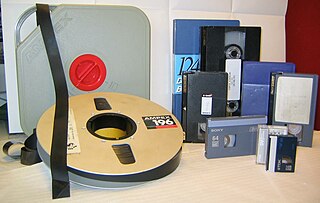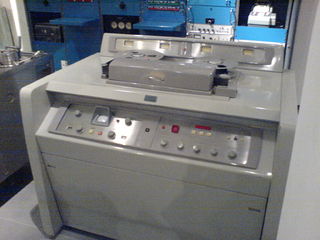Related Research Articles

Magnetic tape is a medium for magnetic storage made of a thin, magnetizable coating on a long, narrow strip of plastic film. It was developed in Germany in 1928, based on the earlier magnetic wire recording from Denmark. Devices that use magnetic tape can with relative ease record and play back audio, visual, and binary computer data.

Videotape is magnetic tape used for storing video and usually sound in addition. Information stored can be in the form of either an analog or digital signal. Videotape is used in both video tape recorders (VTRs) and, more commonly, videocassette recorders (VCRs) and camcorders. Videotapes have also been used for storing scientific or medical data, such as the data produced by an electrocardiogram.
Vision Electronic Recording Apparatus (VERA) was an early analog recording videotape format developed from 1952 by the BBC under project manager Dr Peter Axon.

Ampex Data Systems Corporation is an American electronics company founded in 1944 by Alexander M. Poniatoff as a spin-off of Dalmo-Victor. The name AMPEX is an acronym, created by its founder, which stands for Alexander M. Poniatoff Excellence. Ampex operates as Ampex Data Systems Corporation, a subsidiary of Delta Information Systems, and consists of two business units. The Silicon Valley unit, known internally as Ampex Data Systems (ADS), manufactures digital data storage systems capable of functioning in harsh environments. The Colorado Springs, Colorado, unit, referred to as Ampex Intelligent Systems (AIS), serves as a laboratory and hub for the company's line of industrial control systems, cyber security products and services and its artificial intelligence/machine learning technology.

Helical scan is a method of recording high-frequency signals on magnetic tape, used in open-reel video tape recorders, video cassette recorders, digital audio tape recorders, and some computer tape drives.

A video tape recorder (VTR) is a tape recorder designed to record and playback video and audio material from magnetic tape. The early VTRs were open-reel devices that record on individual reels of 2-inch-wide (5.08 cm) tape. They were used in television studios, serving as a replacement for motion picture film stock and making recording for television applications cheaper and quicker. Beginning in 1963, videotape machines made instant replay during televised sporting events possible. Improved formats, in which the tape was contained inside a videocassette, were introduced around 1969; the machines which play them are called videocassette recorders.

A tape head is a type of transducer used in tape recorders to convert electrical signals to magnetic fluctuations and vice versa. They can also be used to read credit/debit/gift cards because the strip of magnetic tape on the back of a credit card stores data the same way that other magnetic tapes do. Cassettes, reel-to-reel tapes, 8-tracks, VHS tapes, and even floppy disks and early hard drive disks all use the same principle of physics to store and read back information. The medium is magnetized in a pattern. It then moves at a constant speed over an electromagnet. Since the moving tape is carrying a changing magnetic field with it, it induces a varying voltage across the head. That voltage can then be amplified and connected to speakers in the case of audio, or measured and sorted into ones and zeroes in the case of digital data.
A recording head is the physical interface between a recording apparatus and a moving recording medium. Recording heads are generally classified according to the physical principle that allows them to impress their data upon their medium. A recording head is often mechanically paired with a playback head, which, though proximal to, is often discrete from the record head.

U-matic or 3⁄4-inch Type E Helical Scan or SMPTE E is an analogue recording videocassette format first shown by Sony in prototype in October 1969, and introduced to the market in September 1971. It was among the first video formats to contain the videotape inside a cassette, as opposed to the various reel-to-reel or open-reel formats of the time. The videotape is 3⁄4 in (19 mm) wide, so the format is often known as "three-quarter-inch" or simply "three-quarter", compared to open reel videotape formats in use, such as 1 in (25 mm) type C videotape and 2 in (51 mm) quadruplex videotape.

1-inch Type C Helical Scan or SMPTE C is a professional reel-to-reel analog recording helical scan videotape format co-developed and introduced by Ampex and Sony in 1976. It became the replacement in the professional video and broadcast television industries for the then-incumbent 2-inch quadruplex videotape open-reel format. Additionally, it replaced the unsuccessful type A format, also developed by Ampex, and primarily in mainland Europe, it supplemented the type B format, developed by the Fernseh division of Bosch.

D-2 is a professional digital videocassette format created by Ampex and introduced in 1988 at the NAB Show as a composite video alternative to the component video D-1 format. It garnered Ampex a technical Emmy in 1989. Like D-1, D-2 stores uncompressed digital video on a tape cassette; however, it stores a composite video signal, rather than component video as with D-1. While component video is superior for advanced editing, especially when chroma key effects are used, composite video was more compatible with most analog facilities existing at the time.

1-inch Type A Helical Scan or SMPTE A is a reel-to-reel helical scan analog recording videotape format developed by Ampex in 1965, that was one of the first standardized reel-to-reel magnetic tape formats in the 1–inch (25 mm) width; most others of that size at that time were proprietary. It was capable of 350 lines.

2-inch quadruplex videotape was the first practical and commercially successful analog recording video tape format. It was developed and released for the broadcast television industry in 1956 by Ampex, an American company based in Redwood City, California. The first videotape recorder using this format was built the same year. This format revolutionized broadcast television operations and television production, since the only recording medium available to the TV industry until then was motion picture film.
International Video Corporation, or IVC, was a California company with large European operations that manufactured a number of models of middle to high-end video tape recorders, or VTRs, for industrial and professional use in the US, alongside a range of digital video Time Base Correctors and Special Effects units designed and manufactured in the UK. Their products were very popular in the industrial, scientific, research, medical, education, and institutional markets from the late 1960s through the 1980s.

V-Cord is an analog recording videocassette format developed and released by Sanyo. V-Cord was released in 1974, and could record 60 minutes on a cassette. V-Cord II, released in 1976, could record 120 minutes on a V-Cord II cassette.

The 1/4 inch Akai is a portable helical scan EIA and CCIR analog recording video tape recorder (VTR) with two video record heads on the scanning drum. The units were available with an optional RF modulator to play back through a TV set, as well as a detachable video monitor. The Akai Electric Ltd. VTR plant was in Tokyo, Japan.

IVC 2 inch Helical scan was a high-end broadcast quality helical scan analog recording VTR format developed by International Video Corporation (IVC), and introduced in 1975. Previously, IVC had made a number of 1 inch Helical VTRs. IVC saw a chance to make a VTR that would have the quality of the then-standard 2 inch Quadruplex videotape format but with the advantages of helical scan. They then developed a VTR using this technology, the IVC Model 9000.

A videocassette recorder (VCR) or video recorder is an electromechanical device that records analog audio and analog video from broadcast television or other AV sources and can play back the recording after rewinding. The use of a VCR to record a television program to play back at a more convenient time is commonly referred to as time shifting. VCRs can also play back prerecorded tapes, which were widely available for purchase and rental starting in the 80s and 90s, most popularly in the VHS videocassette format. Blank tapes were sold to make recordings.
Longitudinal Video Recording or LVR was a consumer VCR system and videotape standard.
Electronovision was a process used by producer and entrepreneur H. William "Bill" Sargent, Jr. to produce a handful of motion pictures, theatrical plays, and specials in the 1960s and early 1970s using a high-resolution videotape process for production, later transferred to film via kinescope for theatrical release.
References
- ↑ VR-8000 lionlamb.us
- ↑ The Time Line of Extinct Video Tape Recorders
- ↑ VR 1500
- ↑ Signature V metafilter.com/
- ↑ Signature V photos, cedmagic.com
- 1 2 Nafzger, Richard (16 July 2009). ""The Apollo 11 Telemetry Data Recordings: A Final Repor"" (PDF). National Aeronautical and Space Administration. Washington, D.C. pp. 13–16. Retrieved 29 April 2024.
- ↑ Abramson, Albert (September 15, 2007). The History of Television, 1942 to 2000. McFarland. ISBN 9780786432431 – via Google Books.
- ↑ "LabGuy's World: Labguy's Electronics and video projects". www.labguysworld.com.
- ↑ terramedia.co.uk Photo and text of Toshiba VTR
- ↑ "Sony Videoflight". www.smecc.org.
- ↑ "Sony Group Portal - Sony History Chapter14 The Aiborne VTR". www.sony.com.
- ↑ Elkus, Richard (June 16, 2009). Winner Take All: How Competitiveness Shapes the Fate of Nations. Basic Books. ISBN 9780786748556 – via Google Books.
- ↑ "LabGuy's World: Extinct Ampex Video Equipment". www.labguysworld.com.
- ↑ "Ampex VR-420 Half Inch EIAJ VTR". www.labguysworld.com.